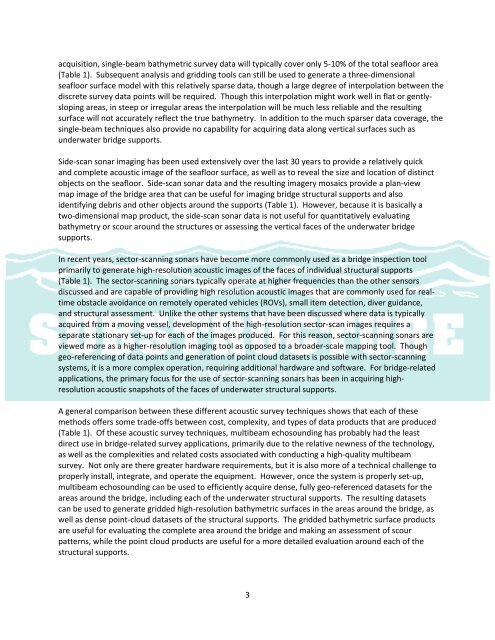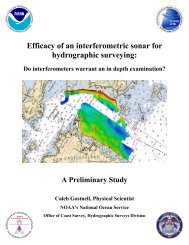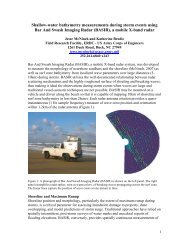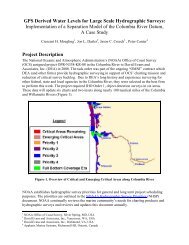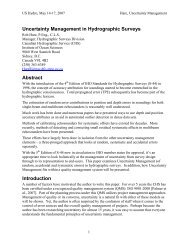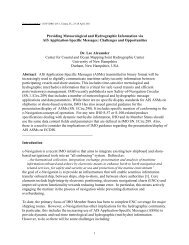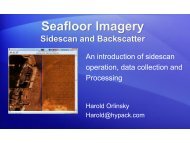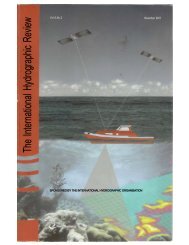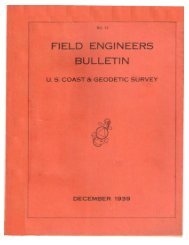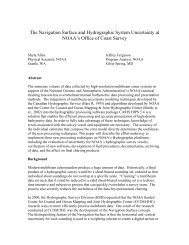High-Resolution Acoustic Multibeam Surveys for Bridge Assessment
High-Resolution Acoustic Multibeam Surveys for Bridge Assessment
High-Resolution Acoustic Multibeam Surveys for Bridge Assessment
You also want an ePaper? Increase the reach of your titles
YUMPU automatically turns print PDFs into web optimized ePapers that Google loves.
acquisition, single‐beam bathymetric survey data will typically cover only 5‐10% of the total seafloor area(Table 1). Subsequent analysis and gridding tools can still be used to generate a three‐dimensionalseafloor surface model with this relatively sparse data, though a large degree of interpolation between thediscrete survey data points will be required. Though this interpolation might work well in flat or gentlyslopingareas, in steep or irregular areas the interpolation will be much less reliable and the resultingsurface will not accurately reflect the true bathymetry. In addition to the much sparser data coverage, thesingle‐beam techniques also provide no capability <strong>for</strong> acquiring data along vertical surfaces such asunderwater bridge supports.Side‐scan sonar imaging has been used extensively over the last 30 years to provide a relatively quickand complete acoustic image of the seafloor surface, as well as to reveal the size and location of distinctobjects on the seafloor. Side‐scan sonar data and the resulting imagery mosaics provide a plan‐viewmap image of the bridge area that can be useful <strong>for</strong> imaging bridge structural supports and alsoidentifying debris and other objects around the supports (Table 1). However, because it is basically atwo‐dimensional map product, the side‐scan sonar data is not useful <strong>for</strong> quantitatively evaluatingbathymetry or scour around the structures or assessing the vertical faces of the underwater bridgesupports.In recent years, sector‐scanning sonars have become more commonly used as a bridge inspection toolprimarily to generate high‐resolution acoustic images of the faces of individual structural supports(Table 1). The sector‐scanning sonars typically operate at higher frequencies than the other sensorsdiscussed and are capable of providing high resolution acoustic images that are commonly used <strong>for</strong> realtimeobstacle avoidance on remotely operated vehicles (ROVs), small item detection, diver guidance,and structural assessment. Unlike the other systems that have been discussed where data is typicallyacquired from a moving vessel, development of the high‐resolution sector‐scan images requires aseparate stationary set‐up <strong>for</strong> each of the images produced. For this reason, sector‐scanning sonars areviewed more as a higher‐resolution imaging tool as opposed to a broader‐scale mapping tool. Thoughgeo‐referencing of data points and generation of point cloud datasets is possible with sector‐scanningsystems, it is a more complex operation, requiring additional hardware and software. For bridge‐relatedapplications, the primary focus <strong>for</strong> the use of sector‐scanning sonars has been in acquiring highresolutionacoustic snapshots of the faces of underwater structural supports.A general comparison between these different acoustic survey techniques shows that each of thesemethods offers some trade‐offs between cost, complexity, and types of data products that are produced(Table 1). Of these acoustic survey techniques, multibeam echosounding has probably had the leastdirect use in bridge‐related survey applications, primarily due to the relative newness of the technology,as well as the complexities and related costs associated with conducting a high‐quality multibeamsurvey. Not only are there greater hardware requirements, but it is also more of a technical challenge toproperly install, integrate, and operate the equipment. However, once the system is properly set‐up,multibeam echosounding can be used to efficiently acquire dense, fully geo‐referenced datasets <strong>for</strong> theareas around the bridge, including each of the underwater structural supports. The resulting datasetscan be used to generate gridded high‐resolution bathymetric surfaces in the areas around the bridge, aswell as dense point‐cloud datasets of the structural supports. The gridded bathymetric surface productsare useful <strong>for</strong> evaluating the complete area around the bridge and making an assessment of scourpatterns, while the point cloud products are useful <strong>for</strong> a more detailed evaluation around each of thestructural supports.3


